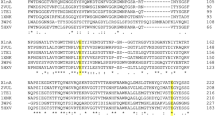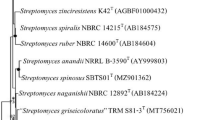Abstract
Microbes play an important role in carbon turnover in forest ecosystems by producing polysaccharide-degrading enzymes such as cellulase, xylanase, and β-glucosidase. In the present study, we isolated a bacterial strain producing cellulase and xylanase from the Forest Park at Gyeongnam National University of Science and Technology using LB agar plates containing 0.5 % carboxymethyl cellulose and 0.01 % trypan blue. Based on 16S rRNA sequencing and API analysis, the isolated strain was identified as a Bacillus species and named Bacillus sp. JYM1. The optimal growth temperature of Bacillus sp. JYM1 was 37 °C. The maximal activities of carboxymethyl cellulase (CMCase) and xylanase were obtained after a 24-h cultivation. The optimal pH and temperature were 6.0 and 50 °C for CMCase and 5.0 and 50 °C for xylanase, respectively. The gene responsible for the xylanase activity in Bacillus sp. JYM1 was cloned and expressed in Escherichia coli. The expressed recombinant protein showed similar biochemical properties to the xylanase of Bacillus sp. JYM1. Therefore, our results confirmed that the gene cloned from Bacillus sp. JYM1, herein named Bxyn, encodes xylanase.







Similar content being viewed by others
References
Annamalai N, Rajeswari MV, Elayaraja S, Balasubramanian (2013) Thermostable, haloalkaline cellulase from Bacillus halodurans CAS 1 by conversion of lignocellulosic wastes. Carbohydr Polym 94(409):415
Araki T, Tani S, Maeda K, Hashikawa S, Nakagawa H, Morishita T (1999) Purification and characterization of β-1, 3-xylanase from a marine bacterium, Vibrio sp. XY-214. Biosci Biotechnol Biochem 63:2017–2019
Ayres E, Steltzer H, Berg S, Wall DH (2009) Soil biota accelerate decomposition in high-elevation forests by specializing in the breakdown of litter produced by the plant species above them. J Ecol 97:901–912
Back SC, Kwon YJ (2007) Optimization of the pretreatment of rice straw hemicellulosic hydrolyzates for microbial production of xylitol. Biotechnol Bioprocess Eng 12:404–409
Beg QK, Kapoor M, Mahajan L, Hoondal GS (2001) Microbial xylanase and their industrial application: a review. Appl Microbiol Biotechnol 56:326–338
Cai YJ, Buswell JA, Chang ST (1998) β-Glucosidase components of the cellulolytic system of the edible straw mushroom, Volvariella volvacea. Enzym Microb Technol. 22:122–129
Cai YJ, Chapman SJ, Buswell JA, Chang ST (1999) Production and distribution of endoglucanase, cellobiohydrolase, and beta-glucosidase components of the cellulolytic system of Volvariella volvacea, the edible straw mushroom. Appl Environ Microbiol 65:553–559
Cantarel BL, Coutinho PM, Rancurel C, Bernard T, Lombard V, Henrissat B (2014) The carbohydrate-active enzymes database (CAZy) in 2013. Nucleic Acids Res 42:D490–D495
Cho KM, Hong SY, Lee SM, Kim YH, Kahng GG, Kim H, Yun HD (2006) A cel44C-man26A gene of endophytic Paenibacillus polymyxa GS01 has multi-glycosyl hydrolases in two catalytic domains. Appl Microbiol Biotechnol 73:618–630
Collins T, Gerday C, Feller G (2005) Xylanases, xylanase families and extremophilic xylanases. FEMS Microbiol Rev 29:3–23
Coughlan MP, Hazlewood GP (1993) Beta-1,4-D-xylan-degrading enzyme systems: biochemistry, molecular biology and applications. Biotechnol Appl Biochem 3:259–289
Demain AL, Newcom M, Wu JHD (2005) Cellulase, clostridia, and ethanol. Microbiol Mol Bio Rev 69:124–154
Duarte MCT, Portugal EP, Ponezi AN, Bim MA, Tagilari CV, Franco TT (1999) Production and purification of alkaline xylanases. Bioresour Technol 68:49–53
Fialho MB, Carmona EC (2004) Purification and characterization of xylanase from Aspergillus giganteus. Folia Microbiol 49:13–18
Guo B, Chen XL, Sun CY, Zhou BC, Zhang YZ (2009) Gene cloning, expression and characterization of a new cold-active and salt-tolerant endo-beta-1,4-xylanase from marine Glaciecola mesophila KMM 241. Appl Microbiol Biotechnol 84:1107–1115
Gupta S, Bhushan B, Hoondal GS (2000) Isolation, purification and characterization of xylanase from Staphylococcus sp. SG-13 and its application in biobleaching of kraft pulp. J Appl Microbiol 88:325–334
Herbert S (2006) Handbook of pulp 1. Wiley, Weinheim, pp 28–30
Huang J, Wang G, Xiao L (2006) Cloning, sequencing and expression of the xylanase gene from a Bacillus subtilis strain B10 in Escherichia coli. Bioresour Technol 97:802–808
Khandeparker R, Verma P, Deobagkar D (2011) A novel halotolerant xylanase from marine isolate Bacillus subtilis cho40: gene cloning and sequencing. N Biotechnol 28:814–821
Kim YK, Lee SC, Cho YY, Oh HJ (2012) Isolation of cellulolytic Bacillus subtilis strains from agriculrural environments. ISRN Microbiol Article ID 650563: 9
Krisana A, Rutchadaporn S, Jarupan G, Lily E, Sutipa T, Kanyawim K (2005) Endo-1, 4-β-xylanase B from Aspergillus cf. niger BCC14405 isolated in Thailand: purification, characterization and gene isolation. J Biochem Mol Biol 38:17–23
Kulkarni N, Shendye A, Rao M (1999) Molecular and biotechnological aspects of xylanases. FEMS Microbiol Rev 23:411–456
Leonowicz A, Cho NS, Luterek J, Wilkolazka A, Wojtas-Wasilewska M, Matuszewska A, Hofrichter M, Wesenberg D, Rogalski J (2001) Fungal laccase: properties and activity on lignin. J Basic Microbiol 41:185–227
Liu R, Qu Y, Jiang Y, Gao P (1999) Purification and characterization of alkaline xylanases from Pseudomonas G6–2. Wei Sheng Wu Xue Bao 39:132–136
MacLeod AM, Lindhorst T, Withers SG, Warren RAJ (1994) The acid/base catalyst in the exoglucanase/xylanase from Cellulomonas fimi is glutamic acid 127: evidence from detailed kinetic studies of mutants. Biochemistry 33:6371–6376
Min SY, Kim BG, Lee C, Hur HG, Ahn JH (2002) Purification, characterization, and cDNA cloning of xylanase from Fungus Trichoderma strain SY. J Microbiol Biotechnol 12:890–894
Nishida Y, Suzuki KI, Kumagai Y, Tanaka H, Inoue A, Ojima T (2007) Isolation and primary structure of a cellulase from the Japanese sea urchin Strongylocentrotus nudus. Biochimie 89:1001–1002
Palmqvist E, Hahn-Hagerdal B (2000) Fermentation of lignocellulosic hydrolyzates. II. Inhibitors and mechanism of inhibition. Bioresour Technol 74:25–33
Qu W, Shao W (2011) Cloning, expression and characterization of glycoside hydrolase family 11 endoxylanase from Bacillus pumilus ARA. Biotechnol Lett 33:1407–1416
Ragauskas AJ, Williams CK, Davison BH, Britovsek G, Cairney J, Eckert CA, Frederick WJ Jr, Hallett JP, Leak DJ, Liotta CL, Mielenz JR, Murphy R, Templer R, Tschaplinski T (2006) The path forward for biofuels and biomaterials. Science 311:484–489
Schallmey M, Singh A, Ward OP (2004) Developments in the use of Bacullus species for industrial production. Can J Microbiol 50:1–17
Schultz J, Copley RR, Doerks T, Ponting CP, Bork P (2000) SMART: a web-based tool for the study of genetically mobile domains. Nucleic Acids Res 28:231–234
Tamura K, Stecher G, Peterson D, Filipski A, Kumar S (2013) MEGA6: molecular evolutionary genetics analysis version 6.0. Mol Biol Evol 30:2725–2729
Tjalsma H, Antelmann H, Jongbloed JD, Braun PG, Darmon E, Dorenbos R, Dubois JY, Westers H, Zanen G, Quax WJ, Kuipers OP, Bron S, Hecker M, van Dijl JM (2004) Proteomics of protein secretion by Bacillus subtilis: separating the "secrets" of the secreome. Microbiol Mol Biol Rev 68:207–233
Tolonen AC, Haas W, Chilaka AC, Aach J, Gygi SP, Church GM (2011) Proteome-wide systems analysis of a cellulosic biofuel-producing microbe. Mol Syst Biol 7:461. doi:10.1038/msb.2010.116
Tolonen AC, Cerisy T, El-Sayyed H, Boutard M, Salanoubat M, Church GM (2015) Fungal lysis by a soil bacterium fermenting cellulose. Environ Microbiol 17:2618–2627
Ulrich A, Klimke G, Wirth S (2008) Diversity and activity of cellulose decomposing bacteria, isolated from a sandy and a loamy soil after long-term manure application. Microb Ecol 55:512–522
Viikari L, Kantelinen A, Sundquist J, Linko M (1994) Xylanases in bleaching: from an idea to the industry. FEMS Microbiol Rev 13:335–350
Waldrop MP, Zak DR, Sinsabaugh RL, Gallo M, Lauber C (2004) Nitrogen deposition modifies soil carbon storage through changes in microbial enzymatic activity. Eco Appl 14:1172–1177
Wang S, Cheng Q, Rials TG and Lee S-H (2006) Cellulose microfibril/nanofibril and its nanocompsites. In: Proceedings of the 8th Pacific rim bio-based composites symposium
Weinert N, Meincke R, Gottward C, Heuer H, Schloter M, Berg G, Smalla K (2010) Bacterial diversity on the surface of potato tubers in soil and the influence of the plant genotype. FEMS Microbiol Ecol 74:114–123
Whistler RL, Richards EL (1970) Hemicelluloses. In: Pigman W, Horton D (eds) The carbohydrates, vol 173. Academic press, New York, pp 697–703
Wilson DB (2011) Microbial diversity of cellulose hydrolysis. Curr Opin Microbiol 14:1–5
Yang JK, Zhang JJ, Yu HY, Cheng JW, Miao LH (2014) Community composition and cellulase activity of cellulolytic bacteria from forest soils planted broad-leaved deciduous and evergreen trees. Appl Microbiol Biotechnol 98:1449–1458
Yasinok AE, Brian S, Kocabas A, Bakir (2010) Xylanase from a soil isolate, Bacillus pumilus: gene isolation, enzyme production, purification, characterization and one-step separation by aqueous-two-phase system. World J Microbiol Biotechnol 26:1641–1652
Zhang XZ, Zhang YHP (2011) Simple, fast and high-efficiency transformation system for directed evolution of cellulase in Bacillus subtilis. Microb Biotechnol 4:98–105
Acknowledgments
This study was supported by Gyeongnam National University of Science and Technology in 2014.
Author information
Authors and Affiliations
Corresponding author
Additional information
Chong Kyu Lee and Min-Yeong Jang have contributed equally to this work.
Rights and permissions
About this article
Cite this article
Lee, CK., Jang, MY., Park, H.R. et al. Cloning and characterization of xylanase in cellulolytic Bacillus sp. strain JMY1 isolated from forest soil. Appl Biol Chem 59, 415–423 (2016). https://doi.org/10.1007/s13765-016-0179-2
Received:
Accepted:
Published:
Issue Date:
DOI: https://doi.org/10.1007/s13765-016-0179-2




